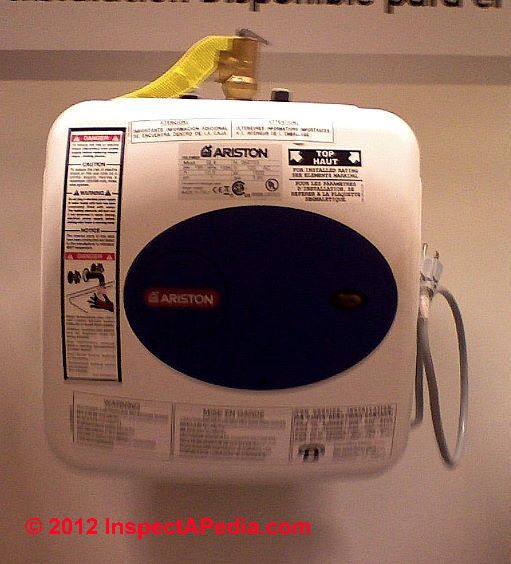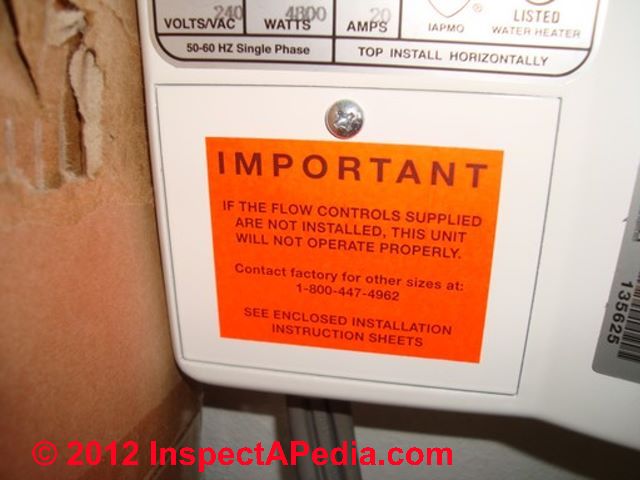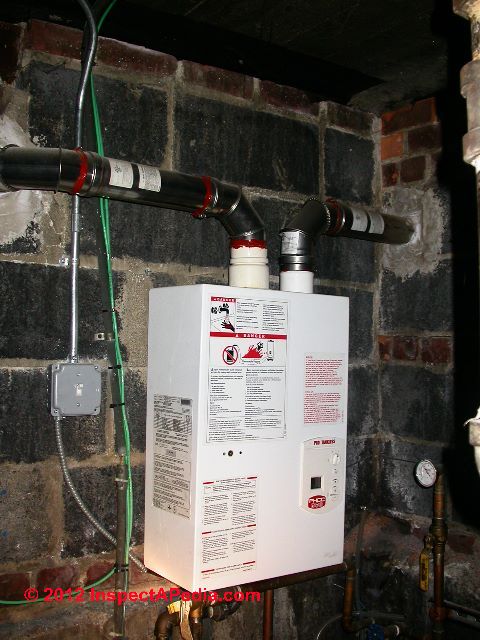 Guide to Tankless Water Heaters
Guide to Tankless Water Heaters
Demand Water Heaters or Instantaneous Water Heaters or
Endless Hot Water Systems
- POST a QUESTION or COMMENT about tankless water heaters, demand water heaters, & point of use water heaters: capacity, sources, installation, troubleshooting, & repair.
Tankless water heaters information home page:
This article series explains the operating characteristics of tankless water heaters, also called instant water heaters or "on demand" water heaters.
Tankless water heaters may be installed to serve a building, building area, or as point of use electric water heaters.
The tankless point of use heaters we discuss include Bosch, Chromolite, Bradford White, Eemax, Instant-Flow, Noritz, Rheem, Rinnai, Stiebel, Takagi, Titan & other brands. We give contact information for each tankless water heater manufacturer. We also describe electric shower heaters: Dur-o-Matic, Marey, & other brands.
InspectAPedia tolerates no conflicts of interest. We have no relationship with advertisers, products, or services discussed at this website.
- Daniel Friedman, Publisher/Editor/Author - See WHO ARE WE?
Guide to Tankless Water Heaters
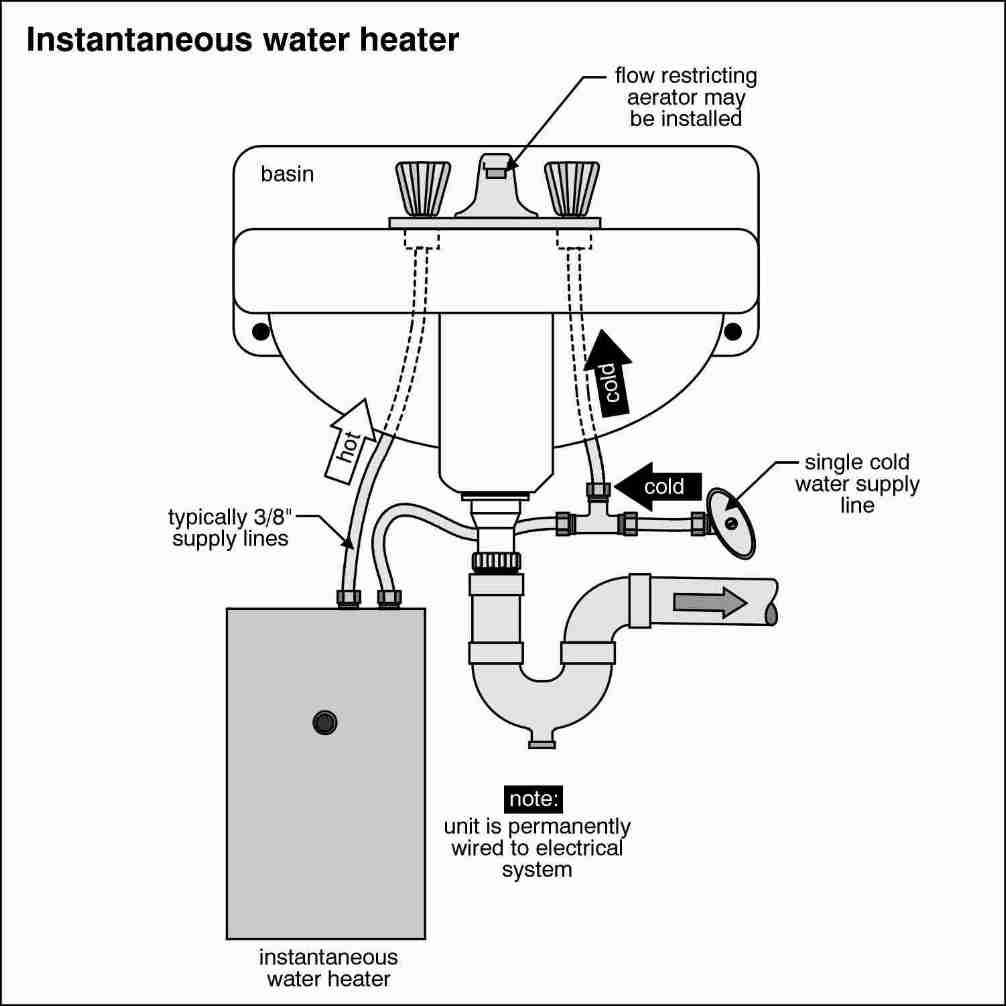 A tankless water heater saves energy by turning off completely when no hot water is being drawn - there are no standby losses - no tank of hot water needs to be kept hot when hot water is not being used.
A tankless water heater saves energy by turning off completely when no hot water is being drawn - there are no standby losses - no tank of hot water needs to be kept hot when hot water is not being used.
Sketch of a point of use tankless (POU) water heater (at left) courtesy of Carson Dunlop Associates, a Toronto home inspection, education & report writing tool company [ carsondunlop.com ].
[Click to enlarge any image]
Article Contents
mAlthough some instantaneous water heaters can provide up to 9 GPM (and use 200,000 BTUH), smaller units cannot provide very large hot water flow rates in gallons per minute.
If the hot water usage rate is expected to be high, a very high BTUH unit (efficient but not necessarily economical) or multiple smaller point of use tankless water heaters may be needed to satisfy all building occupants and uses.
Consumer Reports points out that a tankless water heater may be efficient but not necessarily economical to operate. What they mean is that it is certainly efficient to avoid heating water when no one is using it.
But if water usage is high, a high-BTU tankless water heater may consume more total energy than a large but more conventional oil or gas fired hot water tank and burner.
Tankless Water Heater Operation & Characteristics
 As the name suggests, and as you can see in our photo at left of an electric Instant-Flow water heater, tankless water heaters have no tank, and therefore no storage capacity at all. When the faucets and fixtures in the home are idle, the water heater is dormant.
As the name suggests, and as you can see in our photo at left of an electric Instant-Flow water heater, tankless water heaters have no tank, and therefore no storage capacity at all. When the faucets and fixtures in the home are idle, the water heater is dormant.
No stored hot water means no standby losses, and, if you match the heating capacity of your tankless heater to your hot water flow rate requirements, there is no delay in hot water supply and no running out of hot water.
The Instant-Flow® water heater shown is a Model S-48L/240 240-volt unit rated at 4800 watts and is installed on a 20-A electrical circuit.
Tankless heaters are supplied in all-electric models (shown here) and gas (or possibly oil) fired units that include a burner, heat exchanger, venting system, and the necessary controls.
When a hot water faucet is opened or the dishwasher or clothes washing machine calls for hot water, the tankless heater detects the water flow and ignites the burners.
These powerful burners quickly heat the water inside the small diameter heat exchanger. As hot water is drawn out, fresh cold water is drawn in and the cycle continues.
A significant advantage of this system is that you can't empty all of the hot water out of the tank because there is no tank - just continuous hot water.
No Stored Water
The other major advantage over conventional water heaters is energy savings.
Tankless water heaters have no large reservoir of water that has to be kept hot around the clock in case hot water is needed. One side effect of the lack of storage is that all of the water in the system is cold when the system has not been in operation recently.
When a hot water faucet is operated, it may take more time for hot water to be delivered than in a conventional system.
Small Size
As you can see by our photo (left) of an Ariston tankless water heater, tankless or demand or "instant" water heaters are much smaller than conventional waters with storage tanks, and are usually wall-mounted.
However for non-electric tankless heaters, the burner on a tankless or demand water heater must be much larger than on a conventional heater since it has to instantly heat incoming cold water to its target hot temperature.
Tankless Water Heater Fuel and Venting
Most tankless water heaters are either electric, or they are fueled by natural gas or propane and are vented through a side wall of the house.
As Rheem points out, "The venting must be Category III, Stainless steel, and it applies to the adapter, the vent pipe, all elbows, and terminal vent.
This is important because the flue gases and by-products of combustion can cause condensation
Stainless steel will not deteriorate like type B venting under these conditions."
Tankless Water Heater Efficiency
Tankless water heaters are often much more efficient than conventional water heaters, using modulating burners, direct venting and/or condensing combustion systems.
Mixing Valves / Flow Control Valves used on Tankless Water Heaters
Most systems include a mixing (tempering) valve and a means of setting a maximum water temperature to avoid scalding.
This tempering valve mixes some cold water with the hot water leaving the unit to reduce the temperature.
In one sense, there should be no need for a tempering valve, since we do not need to keep the reservoir water at 140° to prevent Legionnaires Disease.
On the other hand, since we don't know the flow rate of the water through the heater, the tempering valve may be needed since the burner cannot modulate to deliver exactly the temperature we want due to the infinitely variable water flow.
If the flow rate is low, the water moves more slowly through the heater, and picks up more heat from the burner.
Tankless Water Heater Remote Control
Some tankless systems include a remote control, which can be used to monitor the performance of the system, display error codes or change the desired water temperature.
List of Tankless Water Heater Manufacturers, Brands, Contact Information
- WATER HEATER AGE & MANUALS - home - our guide to all brands of water heaters, manuals, contact information, age decoding, repairs.
- [3] Bosch Tankless Water Heaters - http://www.boschhotwater.com/
See details at BOSCH WATER HEATER AGE & MANUALS - [4] Chromolite Tankless Water Heaters
- Cinsa Hidro Tec Instant Water Heaters (Mexico)
- [5] Bradford White Everhot Tankless Water Heaters - Bradford White offers this
See details at BRADFORD WHITE WATER HEATER AGE & MANUALS
step by step HOT WATER RETROFIT Installation (large, slow PDF) - www.bradfordwhite.com - [6] Eemax Tankless Water Heaters - http://www.eemaxinc.com/
- IDEAL HEATING BOILERS - UK Ideal Logic Combi 24 35 35 heater & instant hot water boiler manuals & repair guides
- [7] Instant-Flow Water Heaters, Chronomite Laboratories, Inc., City of Industry CA 91774
- MicroTherm Inc. tankless water heaters, see Seisco below.
- [8] NORITZ Tankless Water Heaters - http://www.noritz.com/
See details at NORITZ WATER HEATER ERROR CODES & MANUALS - [9] RHEEM WATER HEATER AGE & MANUALS
RHEEM TANKLESS WATER HEATER LEAK REPAIR - RHEEM Tankless Water Heaters - http://www.rheemtankless.com/content/
- [10] RINNAI WATER HEATER AGE DECODE, MANUALS, ERROR CODES - Rinnai Tankless Water Heaters - http://www.rinnai.us/tankless-water-heaters/
- RUUD WATER HEATER AGE & MANUALS
- Seisco Tankless Water Heaters, SEISCO TANKLESS WATER HEATERS Product Guide [PDF] (2006) Microtherm Inc., 223 West Airtex, Houston TX 77090 USA, Tel: 8880-296-3338 Web: www.seisco.com
- [11] Stiebel Eltron Tankless Water Heaters - http://www.stiebel-eltron-usa.com/ (shown at above left)
- [12] TAKAGI WATER HEATER MANUALS, AGE, ERROR CODE- Takagi USA Tankless Water Heaters - http://www.takagi.com/
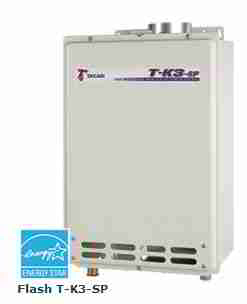
- Takagi tankless water heaters (shown at left) and Takagi radiant heat systems: Takagi combines both radiant heating for floors and domestic hot water production.
- Takagi offers pre-assembled radiant heating system installation packages including for do-it-yourself'ers, and including systems that combine radiant heat flooring with domestic hot water production using a gas-fired tankless water heater. See takagi.com for more information.
"The T-KJr model (gas inputs up to 140,000 BTU per hour) is the smallest unit in the Takagi line-up. The T-KJr is perfect for light residential (i.e. small apartment units) and radiant heating applications."
Image at left is the Takagi T-K3-SP tankless water heater intended for light residential applications, image courtesy of Takagi Corp.
- [13] Titan Tankless Water Heaters - http://www.titanheater.com/
Also see RADIANT HEAT FLOOR MISTAKES where we describe use of small boilers or tankless coil type water heaters for radiant floor heating systems.
Readers should also see ALTERNATIVE HOT WATER SOURCES to distinguish among these types of hot water producing systems
and see ELECTRIC SHOWER HEATERS for a discussion of point of use heaters at shower heads.
The original text of this article was provided courtesy of Carson Dunlop Associates - that text has been edited and may not entirely reflect CD's views.. Our OPINION is that readers looking for plenty of hot water heated efficiently should also consider the heater we describe at Indirect-fired Water Heaters.
...
...
Continue reading at ELECTRIC SHOWER HEATERS or select a topic from the closely-related articles below, or see the complete ARTICLE INDEX.
Or see TANKLESS WATER HEATER FAQs, diagnostic questions & answers posted originally at this page.
Or see these
Tankless Water Heater Articles
- HOT WATER CIRCULATOR PUMP SPEEDS DELIVERY
- TANKLESS COILS
- TANKLESS WATER HEATERS
- ELECTRIC SHOWER HEATERS
- TANKLESS WATER HEATER CAPACITIES
- TANKLESS WATER HEATER CONVERT TO?
- TANKLESS WATER HEATER INSTALLATION
- TANKLESS WATER HEATER INSTALLATION REQUIREMENTS, COSTS
- TANKLESS WATER HEATER LIFE & USES
- TANKLESS WATER HEATER MULTIPLE GANGED
- TANKLESS WATER HEATER REPAIR GUIDE
- TANKLESS WATER HEATER SIZE REQUIREMENTS
- TANKLESS HOT WATER HEATER TEMPERATURE CONTROL
- TANKLESS WATER HEATER WHISTLE
Suggested citation for this web page
TANKLESS WATER HEATERS at InspectApedia.com - online encyclopedia of building & environmental inspection, testing, diagnosis, repair, & problem prevention advice.
Or see this
INDEX to RELATED ARTICLES: ARTICLE INDEX to WATER HEATERS
Or use the SEARCH BOX found below to Ask a Question or Search InspectApedia
Ask a Question or Search InspectApedia
Try the search box just below, or if you prefer, post a question or comment in the Comments box below and we will respond promptly.
Search the InspectApedia website
Note: appearance of your Comment below may be delayed: if your comment contains an image, photograph, web link, or text that looks to the software as if it might be a web link, your posting will appear after it has been approved by a moderator. Apologies for the delay.
Only one image can be added per comment but you can post as many comments, and therefore images, as you like.
You will not receive a notification when a response to your question has been posted.
Please bookmark this page to make it easy for you to check back for our response.
IF above you see "Comment Form is loading comments..." then COMMENT BOX - countable.ca / bawkbox.com IS NOT WORKING.
In any case you are welcome to send an email directly to us at InspectApedia.com at editor@inspectApedia.com
We'll reply to you directly. Please help us help you by noting, in your email, the URL of the InspectApedia page where you wanted to comment.
Citations & References
In addition to any citations in the article above, a full list is available on request.
- [1] Thanks to Alan Carson and Bob Dunlop, Carson Dunlop, Associates, Toronto, for permission to use illustrations from their publication, The Illustrated Home which illustrates construction details and building components. Carson Dunlop provides home inspection education, publications, report writing materials, and home inspection services. Alan Carson is a past president of ASHI, the American Society of Home Inspectors.
- [2] Consumer Reports offers an article on the efficiency versus the economy of tankless water heaters - see http://www.consumerreports.org/cro/Appliances/heating-cooling-and-air/water-heaters/tankless-water-heaters/overview/tankless-water-heaters-ov.htm
- [3] Bosch Tankless Water Heaters - http://www.boschhotwater.com/
- [4] Chromolite Tankless Water Heaters
- [5] Bradford White Everhot Tankless Water Heaters - Bradford White offers this step by step hot water retrofit installation file (large, slow PDF) - www.bradfordwhite.com
- [6] Eemax Tankless Water Heaters - http://www.eemaxinc.com/
- [7] Instant-Flow Water Heaters, Chronomite Laboratories, Inc., City of Industry CA 91774
- [8] Noritz Tankless Water Heaters - http://www.noritz.com/
- [9] Rheem Tankless Water Heaters - http://www.rheemtankless.com/content/
- [10] Rinnai Tankless Water Heaters - http://www.rinnai.us/tankless-water-heaters/
- [11] Stiebel Eltron Tankless Water Heaters - http://www.stiebel-eltron-usa.com/
- [12] Takagi USA Tankless Water Heaters - http://www.takagi.com/
- [13] Titan Tankless Water Heaters - http://www.titanheater.com/
- [14] Takagi tankless water heaters and Takagi radiant heat systems: Takagi combines both radiant heating for floors and domestic hot water production. Takagi offers pre-assembled radiant heating system installation packages including for do-it-yourself'ers, and including systems that combine radiant heat flooring with domestic hot water production using a gas-fired tankless water heater. See takagi.com for more information.
"The T-KJr model (gas inputs up to 140,000 BTU per hour) is the smallest unit in the Takagi line-up. The T-KJr is perfect for light residential (i.e. small apartment units) and radiant heating applications." Image at left is the Takagi T-K3-SP tankless water heater intended for light residential applications, image courtesy of Takagi Corp. - [15] U.S. Department of Energy on Tankless Water Heaters - http://apps1.eere.energy.gov/consumer/your_home/water_heating/index.cfm/mytopic=12820
- Our recommended books about building & mechanical systems design, inspection, problem diagnosis, and repair, and about indoor environment and IAQ testing, diagnosis, and cleanup are at the InspectAPedia Bookstore. Also see our Book Reviews - InspectAPedia.
- In addition to citations & references found in this article, see the research citations given at the end of the related articles found at our suggested
CONTINUE READING or RECOMMENDED ARTICLES.
- Carson, Dunlop & Associates Ltd., 120 Carlton Street Suite 407, Toronto ON M5A 4K2. Tel: (416) 964-9415 1-800-268-7070 Email: info@carsondunlop.com. Alan Carson is a past president of ASHI, the American Society of Home Inspectors.
Thanks to Alan Carson and Bob Dunlop, for permission for InspectAPedia to use text excerpts from The HOME REFERENCE BOOK - the Encyclopedia of Homes and to use illustrations from The ILLUSTRATED HOME .
Carson Dunlop Associates provides extensive home inspection education and report writing material. In gratitude we provide links to tsome Carson Dunlop Associates products and services.


